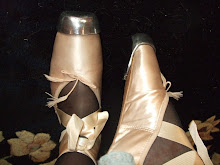
When I was talking to the mother of a dancer.
The New tap dancer did not understand all the language of tap .
So , if anyone did not understand Kathleens answer...
it breaksdown like this:She said Hop ,Shuffle, Step ,Toe Grind ,Brush Step.
Lets take them by themselves
Hop: A jump into the air on one foot: With the weight on one foot and the free foot in the air in any direction, flex the knee of the supporting foot; spring into the air and land on the same foot. Shuffle: Are broken down into 6 types Front, back , Side,Double ,leap and Step ;A forward brush followed by a back brush to the front, side or back,executed rapidly in a 16th note rhythm and counted "a 1"
.Front Shuffle:The basic "Shuffle" - with the feet in line with the hips and the toes directly forward, flex the R knee up in front of body -- lower the leg, striking the toe of the foot against the floor in a forward motion. At this point, the L or supporting leg is straight, where in the R ft is straight and extended forward of the body. As you flexthe R knee, strike the toe of the R ft on the floor in a backward motion. The shuffle should be executed slightly forward of supporting foot. The free foot should always remain in front of the supporting leg by flexing the knee forward and up on the back brush.
Side Shuffle:Extend the right foot to the R side, toes are in line and there is no turnout of the R foot.
Back Shuffle:With the weight on the left foot and knee slightly bent, extend the Rft bk with the toe turned out. From this position, execute theshuffle on the side of the big toe.
Double Shuffle:Two Back Shuffles ("8 and a 1").Shuffle, Leap A forward shuffle on the free foot leaping forward to the same foot.Shuffle, Step A shuffle with the free foot, followed by a step on same foot. Once referred to as a "Three".
Toe: This has 9 types they are: Back ,Beat,Click, Dig,Drop,Heel,Stand, Toetap,and ToetipToe Back Same as a Toe Tap: Strike the point of the toe in back of the standing foot and immediately raise the foot from the floor. Does not take weight.Toe Beat Same as a Toe Tap but the toe remains on the floor.
Click Same as Click Toes: With the weight on the heels of bothfeet (toes up) Strike the toes together.
Toe Dig Emphasized step fwd on the toe of the foot with the kneebent; a strut or jazz type movement.
Toe Drop force the toe to the floor Toe-Heel An old term for a Brush R fwd, Dig R toe In reg. tap it's a Brush R fwd, Dig R heel fwd (toe up).
Toe Stand A movement of the old school of tap wherein the dancer is on the points of both feet.
Toe Tap A striking of the point of the toe in any direction andimmediately raising the foot from the floor.
Toe Tip Same as a Toe Tap.
Grind: A circular movement of the hipsBrush: There are 3 types Brush ,Brush Steps and Brush FlatBrush A one-sound kicking movement, in any direction. With the knee in a flexed position, strike the toe of the free foot against the floor, the leg raises in the air until the knee is straight. This applies when the brush is executed in a forward movement. A brush maybe executed in any direction but basically it is forward or backward.
Brush Step A forward Brush Step is the same as a Flap. Whether it isa forward or back brush step, the movement can be executed in any desired rhythm pattern.
Brush Flat A flat brush is executed in exactly the same fashion as a basic brush - the difference is that the entire Toe of the foot strikes the floor in the pendulum movement.
Flap:A forward brush step: With the knee in a flexed position, strike the toe of the free foot against the floor in a forward motion,stepping forward on the same foot; the step takes weight. May be executed in any direction but normally forward.
Step:There are 4 types ,they are Step, Step Chug,Step Brush/Toe Drop,Step PullStep; A placing of the front part of the foot firmly on the floor,taking weight; always executed on the Toe of the foot unless otherwise noted.
Step Chug A stepping forward on the toe or flat of the foot, followed by a Chug which is an exaggerated heel drop. In toetaps case a exaggerated toe drop Step Brush, toe Drop A basic combining of tap movements:A. Measure Count Movement1 1 Step L bk and Brush R bk2 Drop L toe3 Step R bk and Brush L bk4 Drop R toeStep Pull Also known as a Step, Slide: A step and slide back on same foot. The term "Pull" has been used to mean a Back Brush.
Chug:Sometimes referred to as a Buck: A forward movement accentingthe toe drop: With the weight on one foot, the free foot is raised;force the toe of the foot to the floor with exaggeration, thus moving the foot forward approximately 3 inches.All tap definitions where modified for Toetap
Hope this helps
Paul D. Let me know how I did?








